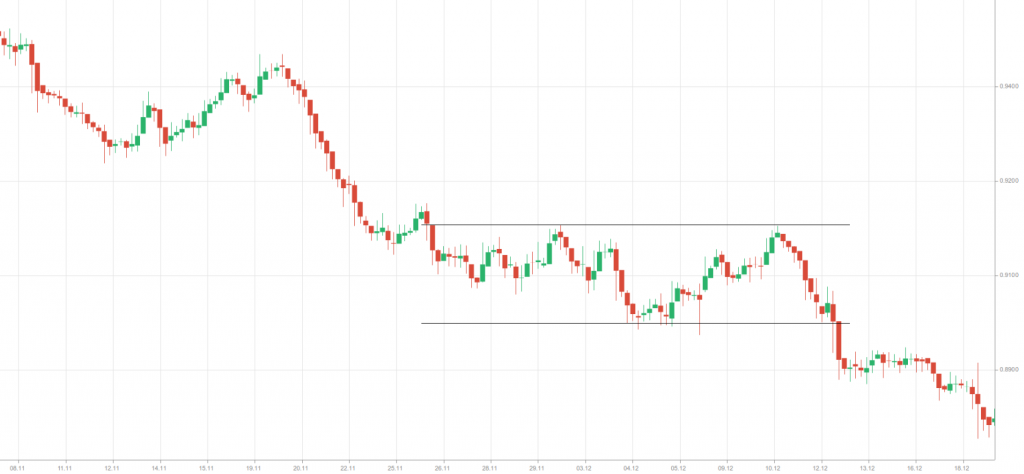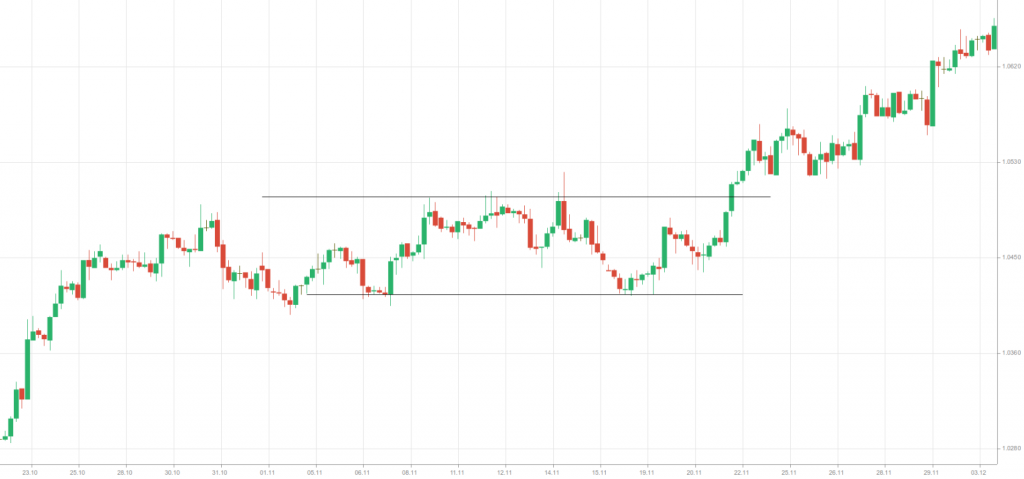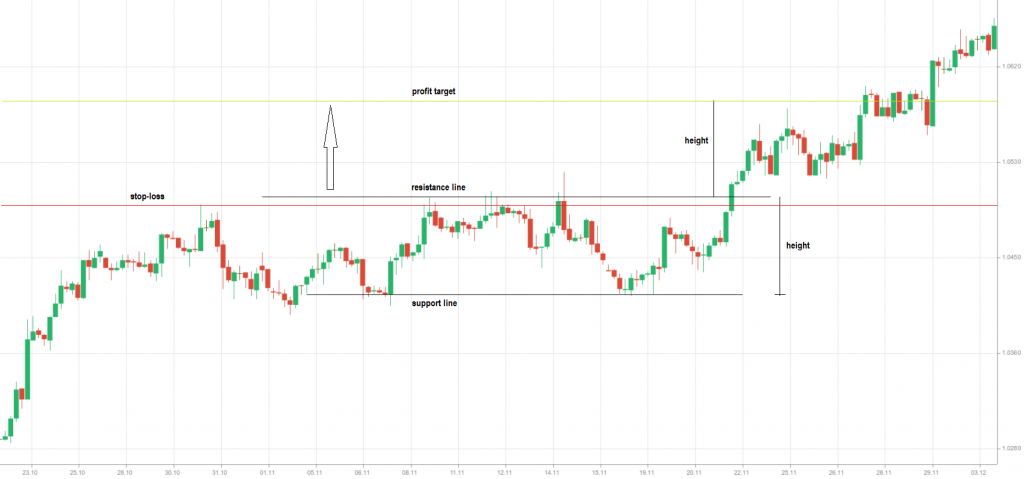Rectangles Price Pattern
This lesson will cover the following
- What is a rectangle?
- What types are there?
- How to trade these patterns?
An overview
A rectangle is usually formed, when price action tends to move between two horizontal lines, with the upper line serving as a resistance, while the lower line serving as a support. Each one of these bounds must also be a trend line, or price action must touch both lines at least twice. This specific moment is what separates rectangles from double tops and double bottoms, which require the occurrence of only three reversals in prices, as we have already noted.
Prices oscillate between the two parallel lines and eventually a breakout occurs in one direction or the other. Rectangles may have a slight tilt up or down, but the two lines (support and resistance) are always parallel. In this regard, they appear similar to horizontal channels. These formations reflect market players indecision, thus, what is of greatest importance here is the direction of the breakout, once it occurs.
Within rectangles, prices may not always touch the two parallel lines. They, instead, produce the so called ”shortfalls”. At times these shortfalls may hint what the direction of the final (real) breakout will probably be.
Here we can see a rectangle with an entry up and a breakout, occurring to the upside.
Rectangle formations may often produce false breakouts, which cannot provide clues in what direction a real breakout may eventually occur. Such breakouts usually are not exits from the rectangle itself. They can be classified as minor breakouts, which appear above or below breakout levels, after which they return back inside the pattern. False breakouts are those, which occur in a direction opposite to the direction of the actual breakout.
Another crucial factor in any pattern is volume. In the case with rectangles, however, whether volume tends to increase or to decrease within the formation causes little or no effect on traders results after the actual breakout. However, results tend to be better, in case the actual breakout is accompanied with rising volume. Volume tends to decrease, as the rectangle develops.
Rectangles may lead to reversal in prices, but they can also serve as trend continuation patterns. In the first case they occur more frequently at bottoms. In the second case they are known as bullish and bearish rectangles.
What is a Bearish rectangle?
This rectangle forms, when prices have been in a downtrend before the appearance of the pattern itself. Prices consolidate inside the rectangle for a certain period of time, after which the downtrend continues. Consolidation area appears, probably because part of the short-positioned traders lock in their gains, while other players wait for small pullbacks to occur, in order to make their entry in the market. Intraday traders look to take advantage of such moves and make profits in a short term.
On the 4-hour chart of AUD/USD above we can see what a bearish rectangle looks like.
What is a Bullish rectangle?
This rectangle forms, when prices have been in an uptrend before the appearance of the pattern itself. Prices consolidate again inside the rectangle for a certain period of time, after which the uptrend continues. Consolidation area appears, probably because part of the long-positioned traders lock in their gains, while others wait for small throwbacks to occur, in order to make their entry in the market.
On the 4-hour chart of USD/CAD above we can see what a bullish rectangle looks like.
How to trade rectangles
Several technical studies have concluded that rectangles more often appear as continuation formations. As two out of three rectangles tend to show trend continuation, at first the expected direction of the breakout should be in consonance with the prior trend. Therefore, in order to trade rectangles, it would be safer for a trader to wait until a breakout occurs.
In this case, the profit target is usually estimated by taking the height of the formation (the distance between support and resistance levels) and place it in the direction of the breakout.
In the case with bearish rectangles, the height should be placed just below the support level, in order to estimate the profit target.
In the case with bullish rectangles, the height should be placed just above the resistance level, in order to estimate the profit target.
In case an upward breakout occurs, stop-losses should be placed just below the upper bound (resistance). However, one may prefer to use a more aggressive strategy – to place his/her stop loss just below the lower bound (support). This way price action is allowed some room.
In case a downward breakout occurs, stop-losses should be placed just above the lower bound (support). If one is willing to be more aggressive, then he/she will place a protective stop just above the upper bound (resistance).
We decided to show an example of how to trade a bullish rectangle. On the 4-hour chart of USD/CAD above we show the position of our protective stop and the position of our profit target, while going long this currency pair. In this case it is appropriate to wait for the green candle, breaching the resistance level to close above this level. The long entry should be, when the next candle begins to form.
There are traders, on the other hand, who would prefer to trade within the rectangle formation itself. In this case they will buy at the level of support and sell at the level of resistance. It is not recommended to use such a strategy, unless the formation is wide enough from its topside to its bottom-side.
Another moment, which needs to be considered, when intending to enter into trades, includes the inherent costs – commissions, slippage and how wide the spread for a particular instrument is.
Also, when trading between two bounds (lines), they are not always exact, while there is no guarantee that an order will be filled exactly at the bound.
Players, attempting to trade this way, will need to place their sell orders a certain distance (filter) below the resistance level (zone) and their buy orders a certain distance (filter) above the support level (zone).
Last but not least, the rectangle formation needs to be high enough from support to resistance, so that traders can achieve results, allowing them to absorb the above mentioned costs and price filters.
Price action has to be watched extremely closely in order to trade within the rectangle. We can say that such a method may be appropriate only for scalpers, as it comes to taking advantage of a number of pips in between the two bounds (and the price filters) in a blink of an eye.


